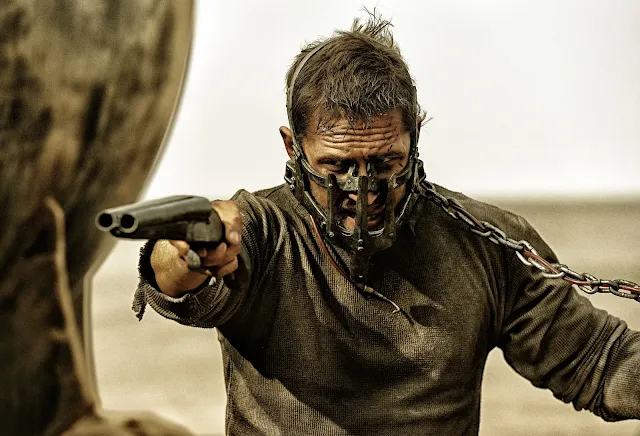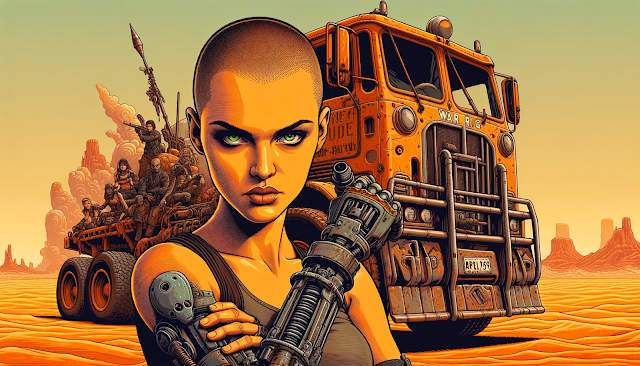At the heart of this cinematic masterpiece lies a simple yet powerful narrative. Max Rockatansky, haunted by his own demons, finds himself caught in a whirlwind of survival and redemption when he crosses paths with the fierce and determined Imperator Furiosa. Together, they embark on an adrenaline-fueled odyssey, fighting against a tyrannical warlord to liberate a group of enslaved women. Yet, within this seemingly straightforward plot lies a profound exploration of humanity, resilience, and the indomitable spirit of hope.
The visual splendor of "Fury Road" is unmatched. The desolate landscapes of Namibia's Namib Desert become a character in their own right, with vast expanses of barren wasteland stretching as far as the eye can see. The sandy dunes and scorched earth mirror the internal turmoil of the characters, creating a haunting backdrop against which their struggles unfold.
But it is the vehicular ballet that truly mesmerizes. A cacophony of roaring engines, screeching metal, and explosive mayhem, the film's automotive madness is a symphony of destruction. Each vehicle, a post-apocalyptic work of art, brims with personality, showcasing the ingenuity and savagery of a world on the edge of collapse. From the menacing War Rig to the grotesque Gigahorse, these mechanical beasts thunder across the screen, leaving a trail of awe-inspiring chaos in their wake.
Yet, amidst the relentless action, "Fury Road" finds its beating heart in its characters. Charlize Theron's Imperator Furiosa is a force of nature, her steely determination and unwavering spirit elevating her to an iconic status. Tom Hardy's portrayal of Max Rockatansky is brooding and enigmatic, conveying volumes through a stoic silence that speaks louder than words. The ensemble cast, from Nicholas Hoult's unhinged Nux to the valiant wives played by Rosie Huntington-Whiteley (The Dark of the Moon), Riley Keough, Zoë Kravitz (The Batman), Abbey Lee, and Courtney Eaton, breathe life into this desolate world, adding depth and emotion to the frenetic proceedings.
Here's some production trivia about Fury Road
- Director George Miller had been planning "Mad Max: Fury Road" since the late 1990s but faced numerous delays and setbacks, including the September 11 attacks and the Iraq War. Miller's vision for the film evolved over time, and he continually refined the script and design elements.
- The film was initially set to shoot in 2001 in Australia, but due to heavy rains, the landscapes turned lush and green, which was not suitable for the post-apocalyptic setting of the film. As a result, the production had to relocate to Namibia, known for its arid desert landscapes resembling the desolate world of Mad Max.
- The production faced financial difficulties, and the collapse of the Australian dollar caused the budget to skyrocket. This forced Miller to postpone filming indefinitely. During this time, he focused on other projects, including the animated film "Happy Feet."
- After years of delays, the project was revived, and filming finally began in 2012. The production took place in Namibia and South Africa, with the deserts of Namibia providing the primary shooting locations for the film's vast, post-apocalyptic world.
- The production faced several challenges during filming. The extreme heat of the desert environment proved physically demanding for the cast and crew. Sandstorms were also a frequent occurrence, causing disruptions and requiring additional measures to protect the equipment and personnel.
- Charlize Theron's character, Imperator Furiosa, was initially written as a male character. However, after meeting with Theron, who expressed her interest in the role, Miller decided to rewrite the character specifically for her. Theron brought a strong and complex portrayal to the character, contributing to the film's feminist undertones.
- Tom Hardy, who played the title character Max Rockatansky, struggled with the physical demands of the role and reportedly clashed with Miller on set. The intense nature of the production, combined with the character's stoic and brooding nature, created a challenging environment. However, they later resolved their differences and maintained a positive working relationship.
- The film heavily relied on practical effects and stunts, with minimal use of CGI. The production featured a large number of real vehicles, stunts, and explosive sequences. The skilled stunt team executed daring maneuvers, and the intricate vehicle designs added to the authenticity and visceral impact of the action scenes.
- The film's extensive post-production process took several years, with the editing process alone lasting over a year. Miller collaborated with editor Margaret Sixel to meticulously craft the film's high-energy pace and intense visual storytelling. The final cut of the film contains roughly 2,700 individual shots, each carefully selected to create a relentless and exhilarating experience.
- "Mad Max: Fury Road" was met with critical acclaim upon its release. It garnered 10 Academy Award nominations, including Best Picture and Best Director for George Miller. The film ultimately won six Oscars, primarily in technical categories such as Production Design, Costume Design, and Film Editing. The recognition solidified the film's status as a groundbreaking work of action filmmaking.
Trivia about Fury Road
- The film had a prolonged development period of nearly two decades, following the release of Beyond Thunderdome. George Miller faced numerous challenges, including financial constraints, changing technology, and global events, before successfully bringing his vision to the screen.
- "Mad Max: Fury Road" was primarily shot in Namibia's Namib Desert, which provided the film with its distinctive barren landscapes. The location's vast red sand dunes and unique geological formations added to the film's otherworldly and desolate atmosphere.
- The movie's production designer, Colin Gibson, and his team were responsible for creating over 150 unique vehicles for the film. Each vehicle was meticulously designed and crafted to reflect the chaotic and scavenged nature of the post-apocalyptic world. The attention to detail in the vehicle designs contributed to the film's immersive and visually stunning world-building.
- One of the most memorable and visually striking vehicles in the film is the Doof Wagon, a massive truck equipped with speakers, drums, and a flamethrower guitar player. The Doof Wagon became an iconic symbol of the film's over-the-top and audacious style.
- The film's score was composed by Junkie XL (Tom Holkenborg), who incorporated unique elements like engine sounds and revving into the music to match the film's high-octane energy. The score played a vital role in driving the action and intensifying the film's relentless pace.
- "Mad Max: Fury Road" was nominated for Best Picture at the 88th Academy Awards, making it the fourth film in the "Mad Max" franchise to receive a Best Picture nomination. The recognition demonstrated the film's artistic and storytelling achievements beyond its action genre roots.
- The film's feminist themes and strong female characters, particularly Imperator Furiosa, received widespread praise for challenging traditional gender roles in action films. The portrayal of Furiosa as a determined, skilled, and multi-dimensional character resonated with audiences and critics alike.
- - "Mad Max: Fury Road" inspired a black-and-white version called "Mad Max: Fury Road: Black and Chrome Edition." This alternate version, released on home media, showcased the film's stunning cinematography in monochrome and emphasized its visual textures and contrasts.
- The success of "Mad Max: Fury Road" led to discussions of potential sequels. George Miller expressed his interest in further exploring the "Mad Max" universe and expanding the story in future films, with the possibility of additional installments focusing on other characters and narratives within the post-apocalyptic world.
- "Mad Max: Fury Road" achieved both critical and commercial success. With a worldwide gross of over $375 million, the film became one of the most financially successful entries in the franchise. Its blend of stunning visuals, exhilarating action, and thematic depth resonated with audiences and solidified its place as a modern action film classic.

















